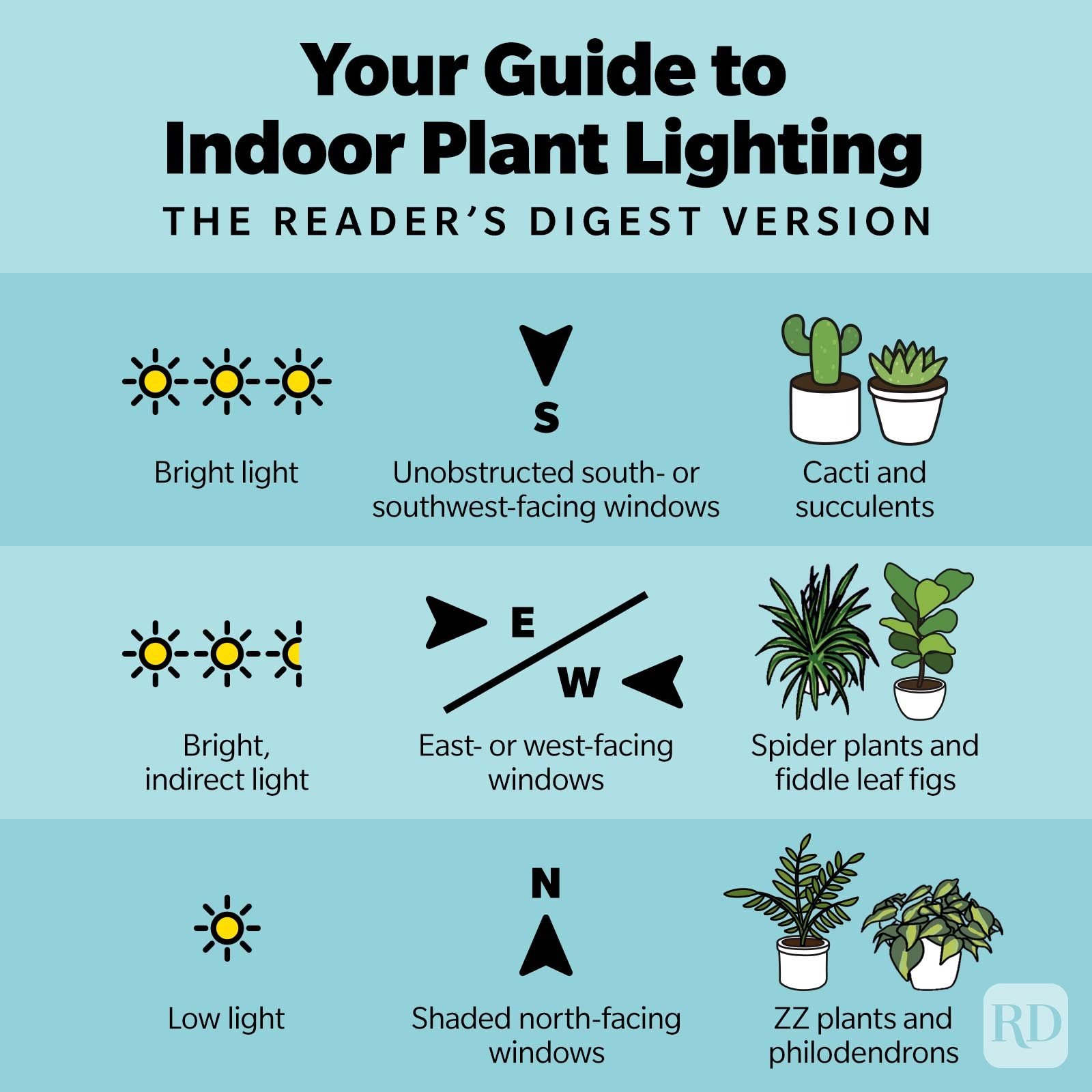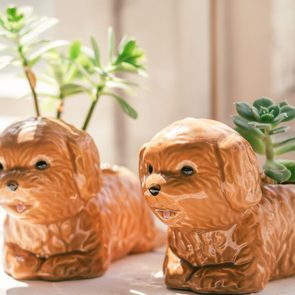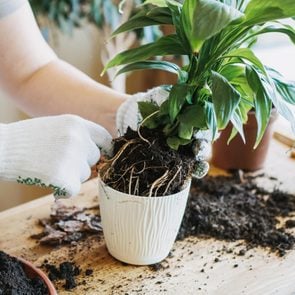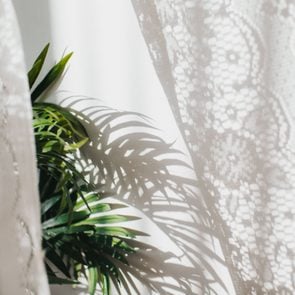6 Indoor Plant Lighting Tips to Help Your Plants Thrive
Updated: Mar. 12, 2024

Light is a plant's lifeblood—even though bright, direct sun isn't always the way to go. Thankfully, this guide to indoor plant lighting will help your garden grow.
We often get hung up on plant watering schedules when nurturing indoor plants. While you need to be able to read the signs that your specimen needs a soaking, a dead plant is inevitable if you don’t start with the right light. Picking the perfect plant for that free space on your windowsill reduces the chances of scorched foliage or unsightly spindly sprouting. Whether you have a low-light indoor plant, like a philodendron, or a cactus that loves bright conditions, follow these indoor plant lighting tips to see them flourish.
Get Reader’s Digest’s Read Up newsletter for humor, cleaning, travel, tech and fun facts all week long.
Why is light important for plants?
Even shade-loving species need some light to grow lush and leafy. Without it, plants can’t produce the essential chemical energy they need to generate nutrients for healthy growth, flowering and seed production.
This plant-specific process, known as photosynthesis, occurs when the energy from sunlight converts carbon dioxide and water into carbohydrates. Inadequate light for indoor plants leads to a depletion in these energy reserves, and eventually, your plant will be beyond saving.
Types of indoor plant lighting
If you’re new to houseplant collecting, you might wonder, “What is bright, indirect light?” You’ll see it and other recommendations on plant-care tags, but those are usually too tiny to provide more information. It’s up to you to make sure you understand all the somewhat vague indoor plant lighting terms—it’s not enough to just pop your plant on a windowsill soaked in the afternoon sun.
Your window size, the direction it faces and any external obstructions (like shade-giving trees or buildings) all influence how much light a room receives. You need to factor in the intensity, duration and quality of the light. Given our adaptable eyes’ poor ability to judge light intensity (especially indoors), getting technical and using a light meter gives you a better idea of where your plant will thrive.
There are several ways to measure light intensity for plants, but foot-candles (fc) is the most common. One foot-candle equals the amount of light a 1-square-foot area receives from a light source equivalent to a candle that’s around a foot away.
By getting a better handle on the different houseplant lighting terms, you’re more likely to pick a plant that’s the right fit for your room.

Bright light
If your plant needs bright light, put it directly in front of or within a few feet of a south- or southwest-facing window with no shady obstructions. In technical terms, these plants are often classified as needing over 1,000 fc and, ideally, at least six hours of direct exposure to the sun.
But even these sun-worshiping species need some darkness for decent development. If you’re using high-intensity grow lights, don’t keep your plant under them for more than 16 hours. And don’t forget that these sun-baked spaces dry out the plant’s potting medium faster, so regularly check the soil with your fingers to assess if it needs watering.
Flowering plants, such as hibiscus and poinsettia, and desert-native cacti and succulents are typical sun-loving species.
Bright, indirect sunlight
Not all plants appreciate the full attention of the sun. So, what is indirect sunlight? It’s a type of light that filters through something—say, a gauzy shade—before hitting your plant.
Plants that need bright, indirect light are best positioned in east-facing windows, where the sun’s rays will be less intense, or near west-facing windows, kept out of direct sunlight. Locations with bright, indirect light get around 250 to 1,000 fc, although optimal growth tends to occur in a position that receives above 500 fc.
Some species can handle a spot near a south-facing window, but you’ll need to soften the sunlight with a shade of lightweight curtains or ensure there’s dappled tree foliage. Light-sensitive plants that require positions on the lower end of the fc scale would do better in front or within a few feet of an unshaded north-facing window or shaded east- or west-facing windows.
Common houseplants that fit into this category include spider plants, monsteras, prayer plants, alocasia and fiddle leaf figs.
Low light
Low-light plants thrive in shaded north-facing windows. They don’t need a lot of natural light to survive and can typically receive between 50 and 250 fc.
Don’t expect low-light plants to be fast growers, and be careful not to overwater. You’re selecting these for their foliage rather than flowers. In the wild, they grow under the branches of larger plants.
Popular examples include cast iron plants, ZZ plants and philodendrons—all species that make good shady, small-windowed bathroom plants.
Signs your plant is getting too much sun
Spotting the early signs your plant is in an overly sunny position means you can move it before it’s too late. “Some common signs a plant is getting too much sun are leaf scorching or discoloration,” says Lisa Muñoz, interior plant designer and founder of Leaf and June.
Vionna Wai, a plant stylist based in New York City and founder of Feline Jungle, says to watch out for fading foliage. “Parts of the plant that receive too much sun will be much lighter than the rest and will start to turn brown from sun damage to the plant cells.” Excessive sun breaks down chlorophyll in foliage, which causes the discoloration.
So if your beloved pothos plant is looking a little faded, move it out of the direct sunlight to a spot where it can get bright but indirect light.
What to do if your plant is getting too much sun
Move your plant to a spot with a little less light, or add a sheer curtain for the filtering effect. But don’t go overboard by banishing it to the darkest spot in your room.
Dry soil aggravates the symptoms of excess sunlight, so boost moisture levels. Just avoid giving your plant a soggy bottom—that leads to root rot.
Heads up: You might be able to move your plant back to a sunnier spot when air temperatures drop. Unfortunately, any scorched leaves will be beyond saving. Remove them so all your plants’ energy focuses on flourishing foliage.
Signs your plant is not getting enough sun
“If your plant isn’t getting enough light, some signs may be spindly or leggy growth, leaning toward the light source or discoloration,” says Muñoz. To produce the green pigment known as chlorophyll, plants need sufficient light. They can turn pale green or even yellow or white without it. Variegated plants can also go from having striking patterns to a solid green color.
You might also see leaf dropping, a disappointing lack of blooms or new leaves that aren’t growing as large or as vigorously as old ones.
What to do if your plant is not getting enough sun
Is your jade plant looking a little worse for wear? Sun-worshipping species that show the signs above may be begging to soak up the rays. If you don’t have a brighter window to pop your plant in, you’ll either need to admit defeat and opt for a different species, or consider investing in grow lights.
Wai considers these lights a super-useful tool for spaces with low lighting conditions, like those with north-facing windows, small windows or a lack of windows. “I use grow lights in the winter when there is a shorter time of daylight, and I have mine on an off/on timer to mimic the natural light cycle,” she says.
Tips for plant lighting
Keep these indoor plant lighting tips in mind when decorating with plants.
- Pick the right plants. Understand what each species needs to thrive. You may adore light-loving succulents, but they might not be the plants for you if you can’t offer them a sunny spot.
- Rotate your plants. Turning a potted plant every so often encourages even growth. “It allows foliage that may not have been getting as much sun to reap the benefits of some brighter light,” says Muñoz.
- Be vigilant. Wai suggests using a plant journal to track your plants’ progress. It makes it easier to spot signs or patterns that suggest lighting (or other care) could be lacking.
- Invest in a light meter. If your plants are constantly discoloring, dropping leaves or dying, pick up a simple, inexpensive digital light meter or use a light meter app on your phone to get a more accurate idea of the types of plants that could survive in your home.
Once you’ve mastered indoor plant lighting, it’s time to stock up on your favorite greenery, from air-purifying plants and medicinal herbs to indoor hanging plants and flowering plants that’ll liven up your decor.
Sources:
- Lisa Muñoz, interior plant designer and founder of Leaf and June
- Vionna Wai, plant stylist based in New York City
- University of Arkansas: “Light and Moisture Requirements for Selected Indoor Plants”
- University of California: “Light and Water Guidelines for Selected Foliage and Flowering Plants”





















